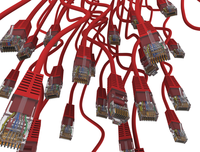
Lead Image © Kirill Cherezov, 123RF.com
Software-defined networking with Windows Server 2016
Virtual Cables
The Network Controller needs to provide the same functionality for both physical and virtual networks as the "IP address management" role service for the management of IP addresses in the network. The difference is that the Network Controller can also centrally manage devices, software, and network appliances from third-party manufacturers. Microsoft has integrated and further enhanced Azure features in Windows Server 2016 for this purpose. In an optimally configured environment, the Network Controller can even provide a kind of software firewall for data centers, including various guidelines, rules, and controls.
In addition to the Network Controller, Microsoft also has expanded the Hyper-V network virtualization (HNV) features significantly. The new switch-embedded teaming (SET) function in Hyper-V on Windows Server 2016 can be used to assign multiple physical network adapters to a virtual switch without having to create a team beforehand. HNV and SET can, of course, also be monitored and managed using the Network Controller, together with System Center Virtual Machine Manager (SCVMM).
Particularly in larger environments, Hyper-V networks comprise numerous VMs, many virtual switches, and various network adapters that connect the hosts to the network. The VMs use virtual network adapters to communicate with the virtual Hyper-V switch, which in turn uses network teams that ultimately communicate with the physical adapters on the host. The physical adapters are connected to physical switches, routers, and firewalls. Special features include quality of service (QoS), HNV, and others.
Clearly, managing virtual networks is becoming more and more extensive, which is exactly where the Network Controller comes into play. Its purpose is to bring order to chaos and to manage and monitor optimally all the components involved. QoS for the various networks obviously plays a role in this area; the individual physical network adapters can be
...Buy this article as PDF
(incl. VAT)
Buy ADMIN Magazine
Subscribe to our ADMIN Newsletters
Subscribe to our Linux Newsletters
Find Linux and Open Source Jobs
Most Popular
Support Our Work
ADMIN content is made possible with support from readers like you. Please consider contributing when you've found an article to be beneficial.






